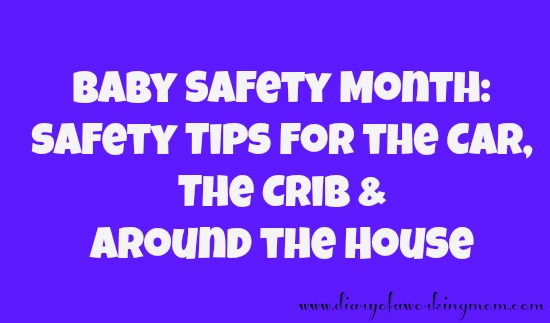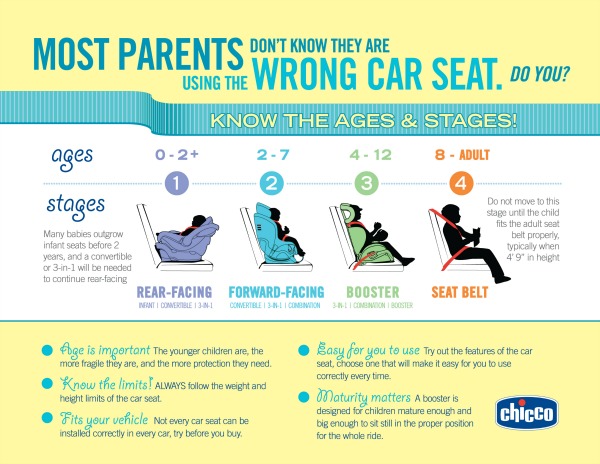 With a new baby expected in less than 2 weeks, our house is in full baby preparation mode. It hasn’t been that long since a tiny newborn graced our door, but when I took the car seat out of storage only to find that it had expired, I was shocked. First, I had forgotten that car seats could even expire, but more than that, it reminded me how important baby safety really is. And what better month to brush up on baby safety than September, which happens to be National Baby Safety Month! So while I’m far from an expert, here are just a few of the things that I’ve learned this month on how to keep our babies safe in the car, in the crib, and at home, along with some startling statistics…
With a new baby expected in less than 2 weeks, our house is in full baby preparation mode. It hasn’t been that long since a tiny newborn graced our door, but when I took the car seat out of storage only to find that it had expired, I was shocked. First, I had forgotten that car seats could even expire, but more than that, it reminded me how important baby safety really is. And what better month to brush up on baby safety than September, which happens to be National Baby Safety Month! So while I’m far from an expert, here are just a few of the things that I’ve learned this month on how to keep our babies safe in the car, in the crib, and at home, along with some startling statistics…
In the Car:
With so many of our hours being spent in the car, it’s sad – but perhaps not surprising – that improper car seat installation and usage account for so many infant injuries each year, many of which stem from the parents improperly transitioning their children from rear facing to forward facing too quickly. In fact, a recent study conducted by Chicco found that less than one-third of parents are following manufacturer’s safety guidelines when deciding to transition their child from rear facing to forward facing, and that half of the parents that are transitioning their children to forward facing base it on comfort rather than safety. With that in mind, here are a few tips from Julie Prom, car seat safety expert and Chicco’s own Car Seat Safety Advocate:
- Rear facing is safest! Both the American Academy of Pediatrics and the National Highway Traffic Safety Administration both recommend kids stay rear-facing as long as possible, with the minimum age for turning them forward facing being 2 years old. If you need further convincing, just check out some of the crash test studies on YouTube. Scary.
- When to transition. When your child approaches a point where you’re considering a booster (4-7 years), make sure that they can actually sit up, sit still, and that the seat belt fits across them properly; most kids are not mature enough to sit without a full harness until they are 5-6 years old.
- Follow instructions. Car seat standards here in the US are stringent for a reason, yet some parents don’t bother to follow the manufacturer’s instructions (or even look for them!). If you’re having a problem installing your seat, check with your pediatricians’ office or police/fire department to see if they can help you – many will provide assistance and safety checks free of charge.
- Avoid accessories. Animal shaped car seat strap covers, toy attachments, and buntings can be tempting, but avoid them because they interfere with the proper harness fit and performance of the seat in a crash.
- Buckle up first. In case of cold weather, place your child in the car seat without bulky clothing or heavy jackets, buckle them up, then give the child a blanket. This will provide the warmth and safety that they need, while still allowing the harness to perform as it should.
- Don’t forget to tether. LATCH makes installing a car seat a snap, so it’s easy to forget to tether the car seat at the top when placing a car seat in the forward facing position. By using the tether, it reduces movement of the seat in the case of a crash, keeping your child safer.

In the Crib:
According to a 19 year study recently published in Pediatrics, 10,000 infants are rushed to the emergency room each year due to crib, playpen, and bassinet injuries, but these are so easily avoided.
- Don’t wait to lower the mattress. Most cribs have 3 or 4 mattress level settings, each of which has a purpose. While the highest setting will work for a newborn, once the child is pulling up and/or mobile, the mattress needs to be lowered. Watch for milestones and adjust your crib accordingly – don’t wait – this will prevent the child from falling out of the crib.
- Place babies to sleep on their back. According to the American Academy of Pediatrics, placing infants to sleep on their backs reduces the risk of SIDS, which is responsible for more infant deaths in the US than any other cause during the first year of a baby’s life.
- Less is better. Keep your baby’s crib clear of quilts, blankets, pillows, stuffed animals, toys, and anything else that isn’t a fitted crib sheet. If your baby likes to be swaddled or needs a blanket, consider using a HALO SleepSack or HALO Swaddle (they even make sleep sacks for big kids!).
- Monitors need some distance. While it’s tempting to place a video or audio device close to or on the crib (especially for those first couple nights when your baby’s in the crib and you’re listening for every little sound), placing a device that close to the crib means cords are also close to the crib. These cords pose a strangulation risk. A better idea is to place the video and audio equipment several feet away from the crib. It should still pick up every noise your baby makes, and is much safer. Speaking of monitors, in light of recent stories involving hackers, make sure that your monitor digitizes and encrypts all transmissions to ensure maximum privacy and security, like the VTech Safe & Sound monitor.
Around the House:
Babies become mobile faster than you think. In fact, it often feels like overnight. So it’s important that you start baby-proofing your home early.
- Gate stairways. Although child stair related injuries are on the decline in the U.S., approximately 100,000 kids are treated in emergency rooms each year for falling down the stairs (which is especially concerning when you take into account that only 2.7% of kids who fall actually go to the hospital!). Baby gates may slow you down when traversing your home, but they’re the easy to install and the fastest way to keep your house safe. They should be installed both at the top and bottom of stairways. And of course, always keep your stairways clear of clutter and encourage use of handrails.
- Secure electronics. According to a recent study, a toppling television sends a child under the age of 18 to the ER every 30 minutes, with kids under the age of 5 being the most at risk. To avoid this, make sure that all tvs are bolted to the wall using the proper mounts.
- Hazardous substances. A study that took place between 1990 and 2006 showed that babies and toddlers between the ages of 1 and 3 are still the most likely to be injured by ingesting common household chemicals (bleach being the most common). Household cleaners should be locked up when not in use. Cabinet latches are an easy and inexpensive way to secure the chemicals. When cleaners are in use, they should be placed out of a baby/toddler’s reach.
- Baby proof from a baby’s perspective. When baby proofing, get down to your child’s level and look around your house. Think about what might grab your baby’s attention and baby proof from there – make sure that the cords for blinds are high up, outlets are covered, and any house plants that may be poisonous are placed out of baby’s reach.
Any safety tips you’d like to share?


A good reminder of all those tips. I get annoyed when I see kids younger than 4 in a booster already.
These are some great tips! I’m sharing with my sisters who both have babies! Thanks for sharing!
These are great reminders! Congrats again on the new addition coming into your family!
I don’t have to worry about this but my niece will be having a baby in February–will forward this on to her!
Great post! With just having a newborn 5 weeks ago these are great reminders!
Awesome tips! The car seat guidelines are soooo important – I hope that parents really take those seriously. You never know what could happen, and your babe or tot can be saved by your due diligence 🙂
Really good tips for any parents with young families, I would have been completely stressed all the time if we hadn’t of had a stair gate, the consequences of not having one doesn’t bare thinking about.
Great info!! I see incorrect placing of a baby in a car seat all the time. That is scary!
What great tips. I had really big babies and it was so tough keeping them rear facing because they hit that 20 pound mark really young, but we did keep them rear facing till they passed the two year mark
Awesome! Its always nice to get a reminder about safety for our children!
Until recently I didn’t know about all these. In fact, some parents still put their children in car seats after 7! September is almost gone and I didn’t even know it was National Baby Safety Month! Ha!